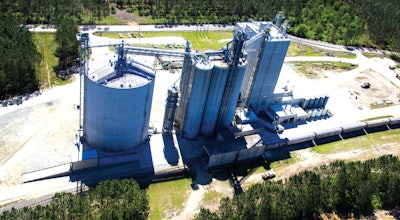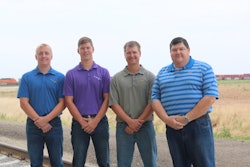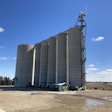

Claxton, GA-based Claxton Poultry Farms is a third-generation family-owned full-service broiler producer that’s thriving thanks to its ability to adapt quickly to consumer demand and provide a superior quality bird.
“Quality and size sets us apart because we’re a smaller vertical operation, so we’re easier to maneuver and willing to do things that bigger companies may not be willing to do,” said Mikell Fries, president, Claxton Poultry Farms. “Location is another competitive advantage for us because we are one of the few plants in the Southeast quadrant that kills two different size birds. We do more under one roof than most companies do.”
In 2016 Claxton Poultry Farms opened the doors to a new 150-ton/hour feed mill in Surrency, GA, decommissioning its Glennville, GA, mill located more than 27 miles away. The Surrency mill was added on to an existing grain elevator and rail receiving location, eliminating the need to haul grain by truck to the feed mill. The new feed facility is larger, the routing and batching is automated, and it features state-of-the-art milling and grinding equipment.
With the values that founder Norman W. Fries instilled in his grandchildren and the new feed mill, Claxton Poultry is poised to gain market share in the U.S. and expand into emerging global markets.
Derailedplans

“We were going to build a new feed mill back in 2000,” said Renault. “The plan was to build a new poultry plant in Waycross, GA, so we commissioned the high-speed rail receiving, grain/soy meal storage, and grain/soy meal load-out systems in Surrency; this was our grain unloading facility to feed the mill in Glennville.”
This portion of the project consisted of 420,000 bushels of whole corn storage in five silos and two interstice bins, and one 1,700-ton soy meal silo with an unloader. The receiving system includes 32,000-bushel/hour rail receiving and 10,000-bushel/hour soft stock receiving.
Plans for the Waycross poultry plant were eventually thwarted by a disaster at another Claxton facility followed by the death of the company’s founder — plus, a downturn in the poultry market in the early 2000s made it a difficult time to expand. The management team, now headed by Norman Fries’ widow Doris, CEO of Claxton Poultry Farms, decided to continue shipping grain to the Glennville feed mill for several more years.
But by 2014 their capacity limitations were undeniable and talks of building the new mill were rekindled. Claxton turned to Younglove Construction L.L.C. — the firm that built the Surrency grain receiving facility in 2001 — to come back and add a new feed mill at the same location.
Feed operations
Construction crews broke ground on the project in September 2014 and slip-formed the feed mill in December that year. From then through throughout 2015, construction on auxiliary buildings and equipment installation took place, and start-up of the facility took place in January 2016. Feed production at near-full capacity of 10,000 tons/week began in February 2016.
Jared Myers, vice president at Younglove, said construction and start-up of the 150-ton/hour mill went as smoothly as it could. He credits Claxton’s planning team and Loren Field, executive vice president, Younglove, for a job well done.
“We all worked together on the front end to figure out what they wanted to build and we stuck to that throughout the project,” said Myers. “It makes everything go more smoothly because everyone knows the expectations. We spent that time at the beginning to build what they ultimately wanted.”

The improvements include a 140-ton-per-hour grinding system; 23 ingredient bins with 3,150 tons of storage; a 12-ton batching and mixing system, including two 12-bin micro systems; and liquid meters to the mixer.
In order to provide sufficient operational and maintenance space for the pelleting system equipment, the pellet mills are housed in a pelleting tower adjacent to the main mill tower. Other features include the continuous-flow-style fats coating system with guided radar continuous level indication in the surge hopper.
Meanwhile, screw conveyors with multiple discharges and distributors are used for pellet distribution into 22 different bins for a total finished feed capacity of roughly 3,300 tons. The load-out is a double driveway design, each with its own 9-ton weigh lorry scale.
To meet their storage requirements, an additional 850,000 bushels of grain storage in a 100-footdiameter concrete silo was built and outfitted with a 1/10-cfm/bushelaeration system, grain temperature detection cables, and stand-alone truck grain receiving system rated at 16,000 bushels/hour.
The operation also includes a 4,000-bushel-per-hour grain dryer system, as well as four 20,000-gallon cone-hoppered fat tanks, one 20,000-gallon fuel oil tank, and five poly tanks of various sizes and capacities.
The new feed mill currently produces 10,000 tons of feed/week and with the addition of another hammermill, it would be capable of producing up to 15,000 tons/week — nearly doubling the capacity of its Glennville feed mill.
Brice Pound, feed mill manager, said in addition to the extra capacity, he enjoys the benefits of automation at the new location.

Even with all of Claxton Poultry’s success in the East, Myers said humility is the company’s secret to longevity.
“They’re very low-key and humble,” said Myers. “It’s a good family company and there are not really many left in this day and age.”






















